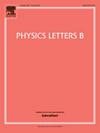Sketching pion and proton mass distributions
IF 4.3
2区 物理与天体物理
Q1 ASTRONOMY & ASTROPHYSICS
引用次数: 0
Abstract
A light-front holographic model is used to illustrate an algebraic scheme for constructing a representation of a hadron's zero-skewness generalised parton distribution (GPD) from its valence-quark distribution function (DF) and electromagnetic form factor, , without reference to deeply virtual Compton scattering data. The hadron's mass distribution gravitational form factor, , calculated from this GPD is harder than ; and, for each hadron, the associated mass-density profile is more compact than the analogous charge profile, with each pion near-core density being larger than that of its proton partner. These features are independent of the scheme employed.
求助全文
约1分钟内获得全文
求助全文
来源期刊

Physics Letters B
物理-物理:综合
CiteScore
9.10
自引率
6.80%
发文量
647
审稿时长
3 months
期刊介绍:
Physics Letters B ensures the rapid publication of important new results in particle physics, nuclear physics and cosmology. Specialized editors are responsible for contributions in experimental nuclear physics, theoretical nuclear physics, experimental high-energy physics, theoretical high-energy physics, and astrophysics.
 求助内容:
求助内容: 应助结果提醒方式:
应助结果提醒方式:


